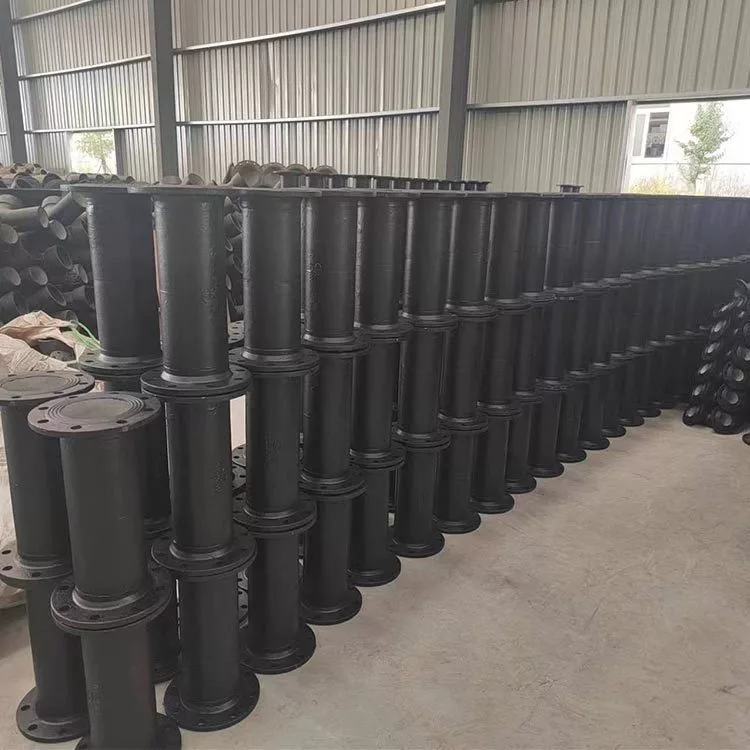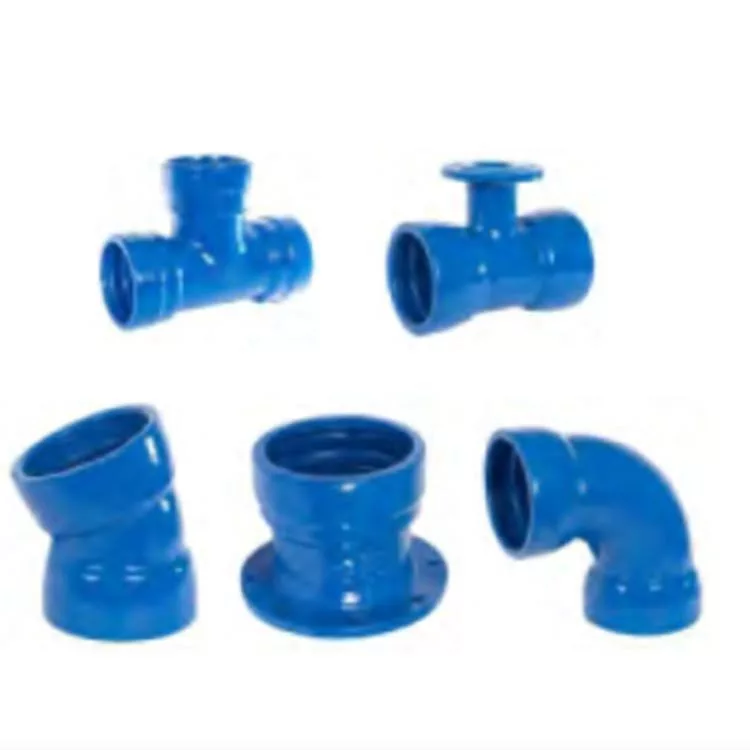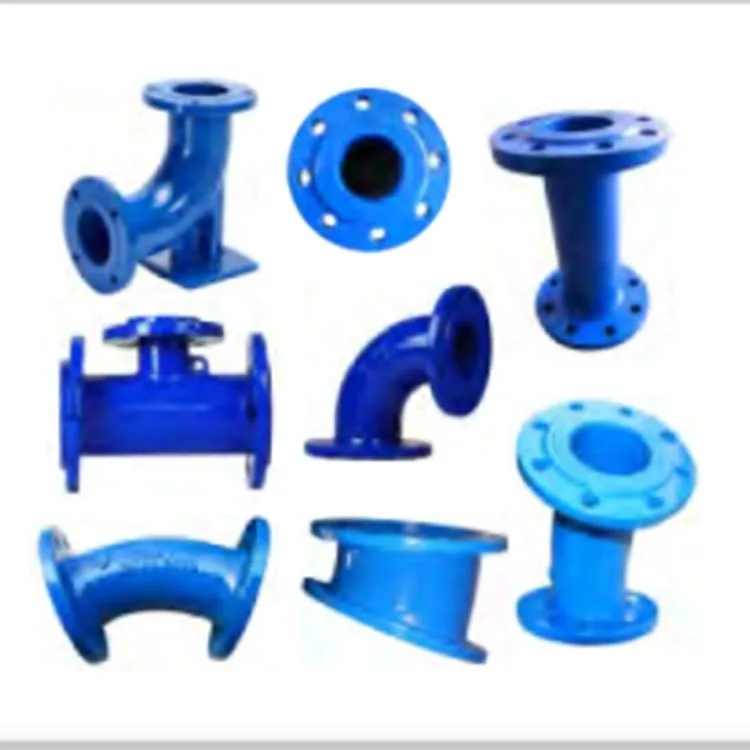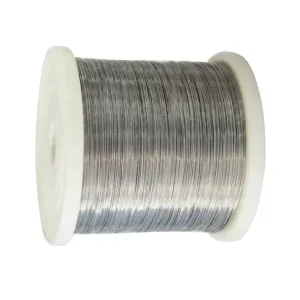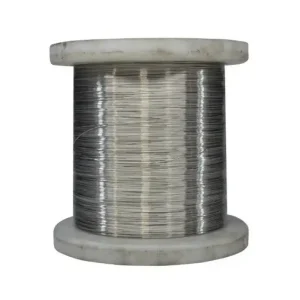Ductile cast iron pipe fittings are precision-engineered components designed to connect, divert, or control fluid flow within ductile iron pipeline networks. Manufactured with spheroidal graphite microstructure, these fittings inherit the high tensile strength (≥420 MPa), impact resistance, and flexibility of ductile iron while providing leak-proof junctions via standardized joint systems. They facilitate directional changes, branch connections, diameter transitions, and flow regulation in water supply, sewage, firefighting, and industrial piping systems, ensuring structural integrity across pressures up to 3.5 MPa (K9 grade) and service lifetimes exceeding 50 years under ISO 2531/EN 545 compliance.
Ductile Cast Iron Pipe Fittings Specifications
| Parameter | Value/Range | Standards | Remarks |
|---|---|---|---|
| Basic Specifications | |||
| Nominal Diameter (DN) | DN 40 – DN 3000 mm | ISO 2531, GB/T 13295 | Customizable per project |
| Pressure Classes | K7, K8, K9, C25, C30, C40 | EN 545, EN 598 | K9/C40 for high pressure (≤3.5 MPa); K7 for low pressure (≤1.0 MPa) |
| Joint Types | T-type (Push-on), K-type (Bolted Gland), Flanged, Mechanical Joint (MJ) | ISO 2531, EN 12842 | Gaskets: SBR/EPDM/NBR rubber (ISO 4633-certified) |
| Mechanical Properties | |||
| Tensile Strength (min) | ≥ 420 MPa | ISO 2531, ASTM A536 | ASTM A536 Grade 65-45-12 (65 ksi tensile, 45 ksi yield, 12% elongation) |
| Yield Strength (min) | ≥ 300 MPa | ISO 2531, GB/T 13295 | 0.2% proof stress |
| Elongation (min) | ≥ 10% | ISO 2531 | 50mm gauge length |
| Hardness | ≤ 230 HB | ISO 6506-1 | Brinell scale |
| Coatings & Linings | |||
| Internal Lining | Cement mortar (≥3.0 mm), Epoxy (200–500 μm), Bitumen | ISO 4179, EN 545 | Optional: Sulfate-resistant cement, ceramic epoxy for sewage (EN 598) |
| External Coating | Zinc (130 g/m²) + Bitumen (≥70 μm), Epoxy, Zinc-Aluminum alloy | ISO 8179 | Corrosion protection for soil/water exposure |
| Fitting Types | |||
| Common Fittings | Elbows (90°/45°), Tees (Equal/Reducing), Couplings, Caps, Reducers, Bends | ASME B16.3 | SCI Ductile Iron Fittings conform to ASME B16.3 dimensions |
| Thread Standards | NPT (ANSI/ASME B1.20.1), BSPT, BSPP | ANSI/ASME B1.20.1 | For threaded fittings (e.g., bushings, unions) |
| Accessories | |||
| Gaskets | SBR, EPDM, NBR rubber | ISO 4633 | Temperature range: -30°C to +100°C |
| Bolts & Nuts | Galvanized carbon steel (G4.8/G8.8), SS304/SS316 | EN 545, EN 598 | For flanged/K-type joints |
| Performance & Testing | |||
| Max. Working Pressure | K7: ≤1.0 MPa; K9: ≤3.5 MPa | ISO 2531 | Pressure class-dependent |
| Hydrostatic Test Pressure | ≥ 5.0 MPa (min) | GB/T 13295 | 2× working pressure |
| Temperature Tolerance | -30°C to +100°C (standard); ≤150°C (epoxy) | ISO 2531 | Epoxy coatings extend upper limit for industrial fluids |
| Design Service Life | ≥ 50 years | ISO 2531 | With proper installation and corrosion protection |
| Certifications | ISO 2531, EN 545 (water), EN 598 (sewage), GB/T 13295, ASME B16.3, NSF/ANSI 61 | Potable water compliance (NSF/ANSI 61) |
Structural Design Features
-
Double‑layer epoxy coating prevents corrosion in aggressive soils.
-
Gasket retention ridge ensures leak‑proof seals under fluctuating pressures.
-
Integrally cast lugs for easy flange bolting and uniform load distribution.
-
Thrust block recess accommodates concrete collars for resisting hydraulic thrust.
-
ISO 2531 compliance guarantees interchangeability with global piping systems.
Global Price Comparison
| Region | Elbow 90° DN 150 (PN 16) | Tee DN 150 (PN 16) | Average Fittings Basket* |
|---|---|---|---|
| Europe | €48.00 | €72.50 | €210.00 |
| North America | US $55.00 | US $80.00 | US $240.00 |
| Asia Pacific | US $25.00 | US $38.00 | US $115.00 |
| Middle East | US $30.00 | US $45.00 | US $135.00 |
Basket = elbow+t ee+coupling at DN 150 PN 16
Prices vary by region due to material costs, labor, and logistics.
Typical Application Scenarios
-
Municipal Water Distribution: Flanged tees and bends for branching mains.
-
Sewage & Wastewater: Push‑on couplings resist infiltration, ideal for DN 300–DN 600.
-
Irrigation Systems: Corrosion‑resistant fittings in agricultural pipelines.
-
Industrial Plants: High‑pressure elbows in chemical and power stations.
Comparative Advantage Analysis
| Feature | MWaolloys DI Fittings | Gray Iron Competitors | Steel Fittings |
|---|---|---|---|
| Ductility | High (≥ 12 % EL) | Low (2–3 % EL) | Moderate (8–10 %) |
| Weight | 20 % lighter | Baseline | Up to 30 % heavier |
| Corrosion Resistance | Superior (epoxy coat) | Moderate (bitumen) | Requires galvanizing |
| Installation Speed | Fast (bolt‑on) | Slow (welding req’d) | Varies |
| Lifecycle Cost | Lowest TCO | Higher maintenance | Moderate |
Installation & Technical Guidelines
-
Torque Specs: 60–80 Nm for M16 flange bolts.
-
Gasket Lubricant: Use EPDM‑compatible grease only.
-
Thrust Blocks: One per change of direction; concrete strength ≥ 25 MPa.
-
Alignment: Use laser levels; ensure pipe grade within ± 2 mm per 10 m.
Quality Assurance & Certifications
-
ISO 9001:2015 quality management system.
-
ISO 14001:2015 environmental management.
-
EN 545 / EN 598 standards for water and sewage fittings.
-
WRAS approved materials for potable water.
-
CE marking under the EU Pressure Equipment Directive.
Frequently Asked Questions
1. What pressure ratings do MWaolloys ductile iron fittings support, and how do I choose the right one?
We manufacture fittings in three standard pressure classes—PN 10, PN 16, and PN 25—corresponding to maximum working pressures of 10 bar, 16 bar, and 25 bar respectively. To select the appropriate class:
-
Assess system design pressure. Check your pump or network’s maximum surge pressure; choose a class at least 25 % higher for safety.
-
Consider water hammer effects. If transient spikes may occur, PN 25 provides extra margin.
-
Factor in temperature. Higher temperatures reduce allowable pressure; see our temperature–pressure derating chart (e.g., at 120 °C PN 16 drops to ~12 bar).
-
Verify standards compliance. All our classes meet EN 545/598 and ISO 2531 requirements, ensuring interchangeability.
2. How do I achieve and verify leak‑proof joints with mechanical and push‑on fittings?
Leak‑proof performance hinges on correct gasket selection, lubrication, and installation:
-
Gasket type: We supply EPDM (– 20 °C to 120 °C) as standard; for oily or high‑temperature services, request NBR or Viton® variants.
-
Lubrication: Use only water‑based EPDM‑compatible grease. Apply a thin, even film on both gasket and spigot.
-
Assembly torque: For mechanical joints, tighten flange bolts to 60–80 Nm in an alternating star pattern. Over‑ or under‑torquing can lead to blow‑outs or leaks.
-
Push‑on installation: Insert the spigot fully until the gasket shoulder contacts the socket entry. Rotate the pipe ¼ turn to seat the gasket.
-
Verification: Conduct a hydrostatic test at 1.5× design pressure for 2 hours; inspect all joints for any seepage before backfilling.
3. What corrosion‑protection options are available for buried and submerged fittings?
Our standard double‑layer epoxy coating (≥ 250 µm total) withstands aggressive soils, but you may choose:
-
Polyethylene sleeving. A heat‑shrink sleeve that adds a polyethylene barrier, ideal for stray‑current areas (per AWWA C105).
-
Polyurethane lining. Provides internal protection against acidic or wastewater environments—meets ISO 12944 C5‑M.
-
Cathodic protection. Install sacrificial anodes or an impressed‑current system for long buried runs.
-
Hot‑dip galvanizing on flanges and bolts to prevent galvanic corrosion at metal‑to‑metal contacts.
4. What are best practices to prevent misalignment and joint stress during installation?
Misalignment causes gasket damage and early failure. We recommend:
-
Use laser or optical alignment tools. Ensure pipe centerlines are within ± 2 mm over 10 m.
-
Support spacing. Install appropriate supports (e.g., roller or fixed pipe supports) every 3–4 m for DN 150 and up, reducing sag.
-
Thrust block placement. Pour concrete thrust blocks against soil, not fitting surfaces, sized per AWWA M9 guidelines.
-
Staged assembly. For long assemblies, install fittings in sections, backfill progressively, and avoid suspended joints.
5. How should I maintain and inspect ductile iron fittings over their service life?
Routine maintenance extends lifespan and prevents costly downtime:
-
Visual inspections. Every 6 months, check exposed flanges and joints for corrosion, paint blistering, and bolt looseness.
-
Torque re‑check. After the first 3 months of operation, verify flange bolt torque; retighten to 60–80 Nm if needed.
-
Coating integrity. After 5 years, spot‑test epoxy thickness with a magnetic gauge; repair any areas below 200 µm.
-
Leak detection. Use acoustic monitoring or tracer gas for buried mains to locate small leaks before they become major.
-
Record keeping. Log all inspections, repairs, and replacements in a maintenance database—critical for regulatory compliance.
6. Can MWaolloys fittings handle elevated temperatures or chemically aggressive fluids?
Yes. Temperature and chemical compatibility depend on gasket, lining, and coating selection:
-
High‑temp service: With specialized EPDM or Viton® gaskets and heat‑resistant epoxy, fittings operate up to 180 °C.
-
Acidic fluids: Internal polyurethane linings protect against dilute acids (pH > 3); for stronger chemicals, consult our corrosion‑engineering team.
-
Oils & hydrocarbons: NBR or FKM gaskets resist petroleum products; we also offer carbon‑steel internal sleeves for fuel lines.
-
Steam applications: Use stainless‑steel clamps and high‑temp gaskets; maintain operating pressure below derated limits per EN 545.


